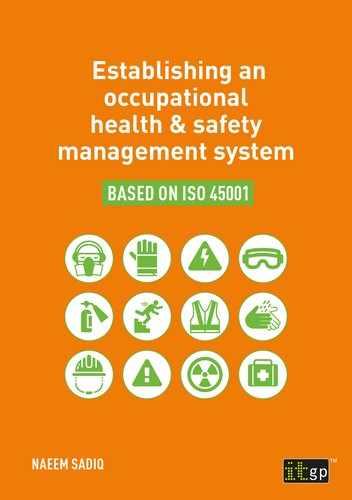APPENDIX G: A SAMPLE PROCEDURE FOR IDENTIFYING AND MANAGING OCCUPATIONAL HEALTH HAZARDS
1. Purpose: The purpose of this procedure is to define the process of identifying and managing occupational health related hazards at Safe and Sound Steel Manufacturing (SSSM).
2. Responsibility: Factory doctor has overall responsibility to implement and maintain this procedure.
3. Procedure: Factory doctor or his nominated healthcare professional shall be an integral part of the risk assessment team for all locations, processes and activities of the factory.
a. Factory doctor shall coordinate with the factory OH&S manager to conduct health hazard identification and risk assessments.
b. Factory doctor will ensure that health hazards such as the one’s listed below are identified and recorded in the risk assessment register.
•Contact with or inhalation of hazardous substances such as acids, caustic substances, disinfectants, glues, heavy metals (including mercury, lead, silica, asbestos, ammonia, cadmium and aluminium), paints, pesticides, petroleum products and solvents.
•High levels of noise, dust, fumes, mists, eye stress, musculoskeletal stresses, poor ergonomic conditions, radiation and extreme high or low temperatures.
•Psychosomatic illnesses.
•Harmful or asphyxiating gases, allergens, carcinogen and biological, infective and parasitic agents.
•Tasks that require special health conditions to be addressed, such as working at height or working in confined spaces.
c. Factory doctor shall consider health hazards to individuals who may be vulnerable because of gender, age, height, vision, hearing, phobias, epilepsy or any other condition, capability or disability. These factors shall be considered during the risk assessment process to ensure that such vulnerable individuals are not exposed to unsafe situations.
d. An annual medical examination shall be carried out for all employees. In addition, medical tests and examinations shall be established for persons with job-specific health risks, as identified by the organisation or as required by law.
e. Subject to local legislation, the factory doctor shall define and display a policy on smoking, drug and alcohol use and a supporting programme for managing employee drug and alcohol misuse at work.
f. Factory doctor shall maintain the latest list of applicable occupational health legislation, and shall ensure that the factory complies with each one of them.
g. Factory doctor shall ensure that medical support and onward referrals are readily available to all employees in all shifts operated by the factory.
h. Factory doctor shall also ensure that all employees have access to advice and support on maintaining a healthy lifestyle and any identified local public health issues, with inputs on behavioural changes wherever needed.
i. Factory doctor shall ensure functionality of all medical equipment and availability of ambulance at all times.
j. Factory doctor shall establish and implement a programme of appropriate health screening designed to manage the risk of all canteen employees who handle food. A list of such employees shall be maintained.
k. Factory doctor shall establish and implement a health surveillance programme. This shall consist of appropriate screening (checks and tests) along with the frequency, for all employees who work at locations/processes where they are exposed to special or high health related risks. A list of such locations, employees and tests shall be maintained. Please refer to SSSM Occupational Health Surveillance Programme (SSSM-HS-01) for details.
l. Factory doctor shall ensure safe drinking water, sanitation and hygiene at the workplace.
m. Factory doctor shall ensure that designated employees are given initial and refresher first-aid training to handle emergency situations. A list of such employees shall be maintained.
n. Medical records of employees shall be kept confidential and must be kept secure for a minimum of five years after leaving employment.
Supporting references:
•For retention of records, see procedure SSSM-R-01.
•For training and competence requirements of risk assessment team, see SSSM-T-01.
•For MSDS requirements, see SSSM-PMSDS-01.
•For health surveillance plan, see SSSM-HS-01.
•For latest laws on hazardous substances, see COSHH website.
•For identification of hazards and assessment of risks, see SSSM-RA-01.
